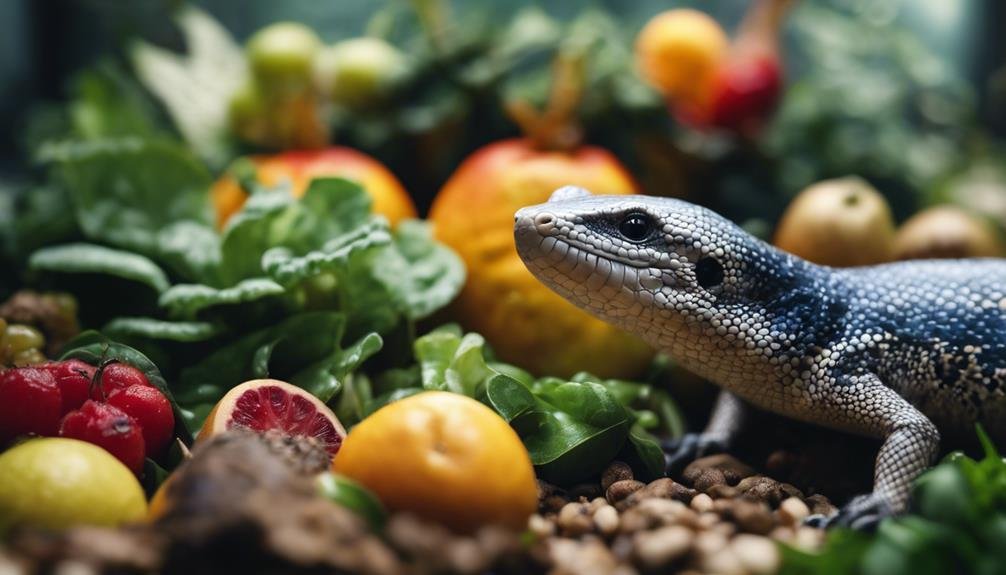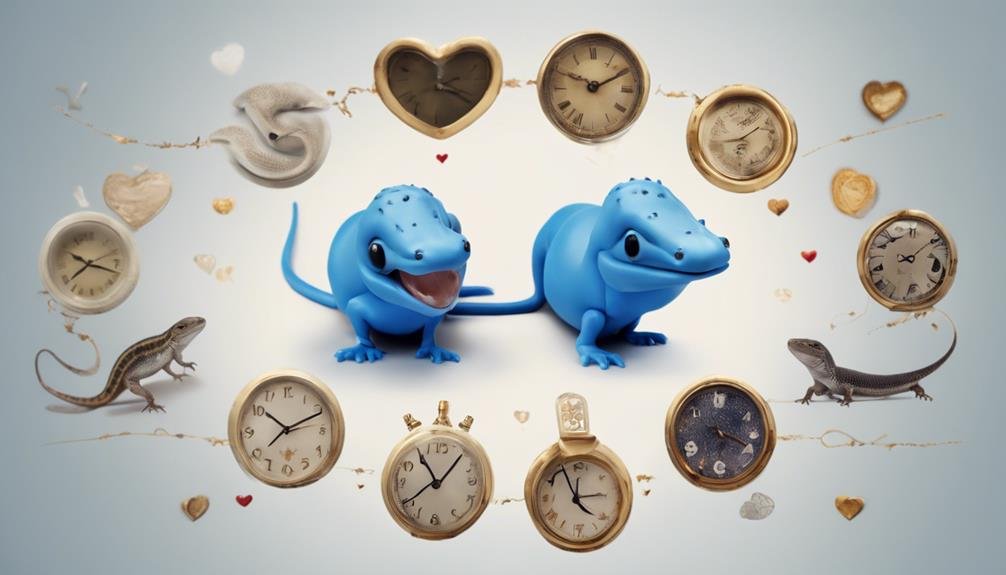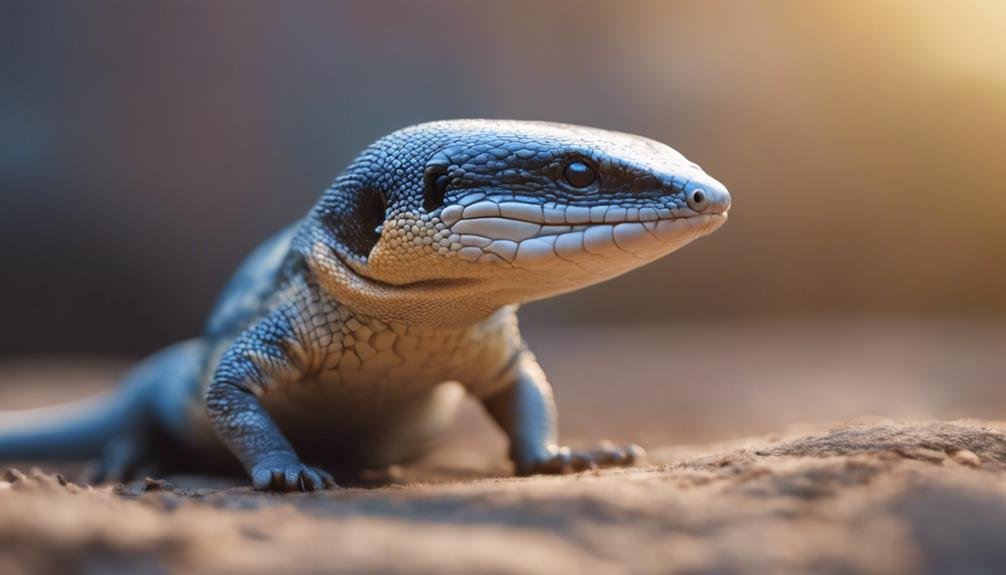If you're considering a blue-tongued skink as a pet, you're probably curious about how long they can be a part of your family. With a potential lifespan of 15 to 30 years, these reptiles are a long-term commitment that demands more than just love and affection. Proper care, including a balanced diet, suitable habitat, and regular health checks, plays an essential role in how long they'll thrive under your care. But what exactly does 'proper care' entail, and how can you guarantee your skink lives a full, happy life? Let's explore the essential components and some lesser-known tips that could extend the life of your scaly companion.
Key Takeaways
- Blue-tongued skinks have a lifespan ranging from 15 to 30 years, influenced by genetics, diet, and habitat.
- Managing stress, offering a balanced diet, and ensuring regular veterinary check-ups are crucial for longevity.
- Optimal habitat setup includes temperature gradients of 75-85°F, hiding spots, and a secure enclosure.
- Diet should be 60% plant food and 40% animal protein, supplemented with reptile multivitamins and calcium carbonate.
- Regular health monitoring, including weight checks and behavior observation, is essential for early detection of potential issues.
Understanding Lifespan Variability
The lifespan of blue-tongued skinks varies considerably, influenced by factors such as genetics, diet, and habitat conditions. When you're diving into the world of Blue Tongue Skink Lifespan, understanding lifespan variability is important. These reptiles can thrive for 15-20 years, sometimes even hitting the 30-year mark, but it's not just by chance. Genetics play a role, but how you manage their diet, stress levels, and living conditions makes a significant difference.
You've got to keep stress levels low and make sure regular veterinary check-ups to catch any potential issues early. A balanced nutrition is essential; it's the cornerstone of their health. Providing a suitable environment goes beyond just temperature and space; it's about creating a home that mimics their natural habitat as closely as possible.
Optimal Habitat Setup
Creating your blue tongue skink's ideal habitat requires attention to temperature gradients, ranging from 75-85°F, to closely replicate their natural living conditions. This essential habitat setup is vital for the health and happiness of blue tongue skinks in captivity.
To achieve this, you'll need to make sure that your enclosure offers a variety of hiding spots and a shallow water dish for soaking, both of which are necessary for your skink's well-being.
Choosing the right substrates, such as cypress mulch or coconut coir, is key to facilitate burrowing behavior, allowing your skink to exhibit natural instincts. Remember, the comfort and security of your blue tongue skink also depend on the cleanliness of its habitat. Regular cleaning and disinfecting are non-negotiable practices to prevent health issues and maintain an environment where your skink can thrive.
Lastly, don't overlook the importance of a secure lid on the enclosure. It's not just about keeping your skink safely inside; it's about ensuring that no unwanted guests can intrude. This attention to detail in creating an excellent habitat setup is what makes the difference for blue tongue skinks in captivity, contributing to their overall health and longevity.
Diet and Nutrition Essentials


For the essential health of your blue-tongued skink, it's important to provide a balanced diet consisting of 60% plant food and 40% animal protein. This mix guarantees your scaly friend gets all the necessary nutrients for a long and healthy life. Including a variety of vegetables and fruits in their diet, alongside high-quality animal protein sources like crickets, mealworms, and small rodents, is necessary.
You've got to be mindful about their nutrition, incorporating reptile multivitamins and calcium carbonate into their meals to prevent any nutritional deficiencies. These supplements play a crucial role in maintaining their bone health and overall vitality. Remember, the diversity in their diet not only keeps them healthy but also makes mealtime more engaging for them.
Offering a varied diet with multiple protein sources is key. It's not just about meeting their dietary needs; it's about enriching their lives. With the right diet and proper nutrition, your blue-tongued skink could thrive for up to 20-30 years in captivity, showcasing the direct impact of diet on their lifespan. So, make sure you're providing everything they need to live a long, happy life.
Health and Wellness Monitoring
Monitoring your blue-tongued skink's health through regular weight checks and observing behavior changes is essential for their well-being. Keeping tabs on their weight can alert you to any significant shifts that might affect their lifespan. A sudden drop or increase should prompt a closer look into their diet, environment, or potential health issues.
Pay close attention to your skink's appetite too. A decrease is often the first sign of trouble, signaling possible health concerns that need addressing. Equally, changes in behavior, such as increased lethargy or an unusual level of activity, can indicate stress or illness. It's these subtle cues that can make a big difference in their overall health monitoring.
Respiratory infections are another threat to watch out for. Signs like wheezing, nasal discharge, or labored breathing require immediate attention. Ensuring the humidity levels in their habitat are correct is vital to prevent these and other issues, like dehydration or shedding problems. Proper health monitoring goes beyond simple observation; it involves creating an environment that supports their well-being, directly impacting the blue tongue skink's lifespan.
Breeding and Age Factors


Understanding the breeding patterns and age-related factors is crucial for anyone looking to support the long-term health and vitality of their blue-tongued skink. These fascinating reptiles reach sexual maturity between 18 to 24 months, setting the stage for a life filled with potential breeding opportunities. The prime time for breeding these skinks is in the spring or early summer, aligning with their natural cycles in the wild.
Female skinks start a gestation period lasting 3 to 4 months, after which they can surprise you with a litter of 5 to 15 live young. This capability to produce live offspring rather than laying eggs sets them apart from many other reptiles. While it's possible for skinks to breed annually, it's wise to give them a break between breeding seasons. This rest period helps maintain their health and makes sure they're ready for the next cycle.
In captivity, with the right care, your blue-tongued skink can enjoy a lengthy lifespan of 15 to 20 years, and some even reach the ripe old age of 30. Knowing these breeding and age factors can help you provide a nurturing environment that supports their well-being through every stage of life.
Is a Blue Tongue Skink’s Lifespan Affected by its Behavior?
The lifespan of a blue tongue skink is greatly influenced by its behavior attitude. A healthy and well-behaved skink will likely live longer than one with aggressive or stressed behavior. Environmental enrichment and proper care can positively impact a blue tongue skink’s behavior, ultimately extending its lifespan.
Frequently Asked Questions
What Do You Need to Know About Blue-Tongue Skinks?
To care for blue-tongue skinks, you'll need to:
- Nail their diet
- Set up their habitat correctly
- Understand their daily handling needs
Pay attention to:
- Their skin shedding
- Learning to spot healthy vs. concerning signs
Breeding behavior can offer insights into their wellbeing. It's essential to keep their temperature and humidity controlled. Don't forget about their need for social interaction, even if it's just with you.
How Do I Know How Old My Blue-Tongue Is?
To gauge your blue-tongue skink's age, monitor its growth rings, weight, and coloration changes closely. Scale condition and feeding behavior also offer clues. Younger skinks tend to be more vibrant and active, with clear eyes and smoother scales.
As they age, activity levels may drop, and their tail thickness can vary. Behavioral signs, like how they interact with their environment, also shift with age. Consulting a professional can provide more precise insights.
How Long Do Pet Blue-Tongue Skinks Live?
Your pet blue-tongue skink can live up to 20 years with the right care. Key factors include dietary importance, ensuring proper temperature control and humidity levels, regular health checks, and an enclosure that suits their size.
Understanding their social behavior, activity patterns, and breeding facts also plays a role. Don't forget about enrichment ideas to keep them engaged. All these aspects contribute to a happy, healthy life for your skink.
Are Blue-Tongue Skinks Hard to Take Care Of?
You might think taking care of blue-tongue skinks is tough, but it's quite manageable. With the right habitat setup, temperature control, and humidity levels, they thrive.
Paying attention to their diet, helping them during shedding, and regular health monitoring, including vet visits, are crucial.
Don't forget about gentle handling and observing their behavior for signs of stress or illness. All these steps guarantee your skink stays healthy and happy in your care.
Conclusion
In wrapping up, you've learned that with the right care, your blue-tongued skink can live up to 30 years.
It's all about creating the perfect habitat, nailing their diet, and keeping an eye on their health.
Remember, regular vet visits and a keen eye on their behavior and weight are your best tools.
If you're up for the challenge, breeding can also be a rewarding journey.
Here's to many happy, healthy years with your scaly friend!


